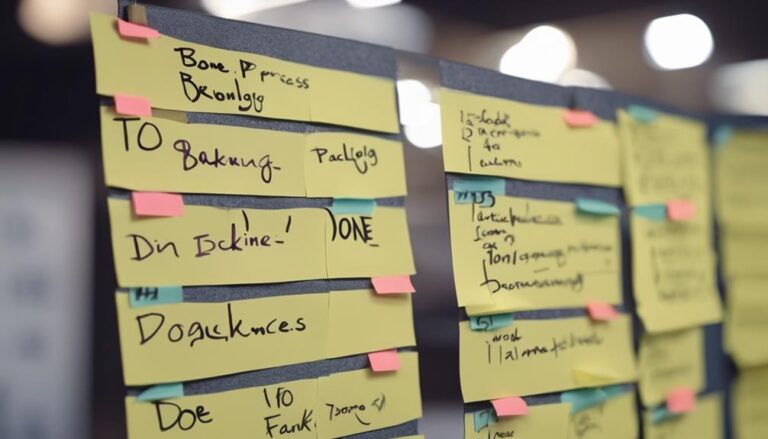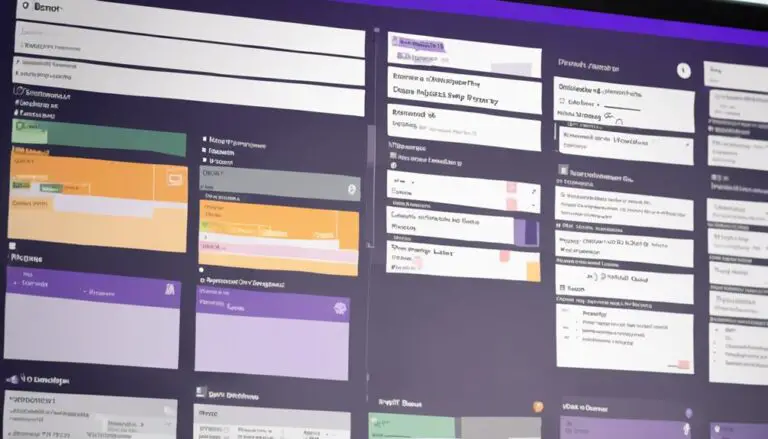When it comes to applying Kanban effectively, think of it as a tailored suit – fitting perfectly when aligned with the right situations. But how do you know which scenarios are the ideal fit for this method? To determine the best situations for implementing Kanban, it’s important to assess the nature of the work, the team’s capacity, and the desired workflow. For example, Kanban is well-suited for teams with constantly changing priorities or short lead times, as it allows for flexible and adaptive workflow management. Additionally, Kanban scaling tips can provide guidance on how to effectively apply this method in larger or more complex organizations, ensuring that it remains a perfect fit for any situation.
Understanding the nuances and complexities of your workflow is just the beginning. By exploring key factors like team dynamics, project intricacies, and adaptability requirements, you can unlock the true potential of Kanban.
Ready to discover how this powerful tool can revolutionize your work processes?
Key Takeaways
- Identify workflow bottlenecks for targeted improvements.
- Visualize work stagnation to optimize Kanban system.
- Prioritize tasks based on urgency, impact, and team capacity.
- Utilize data-driven insights for effective task prioritization.
Identifying Workflow Bottlenecks for Kanban Application
To effectively implement Kanban, start by pinpointing stages in your workflow where tasks slow down or get stuck. Identifying workflow bottlenecks is crucial for optimizing your Kanban system.
By analyzing tasks and addressing these bottlenecks, you can reduce lead times, increase productivity, and ensure efficient resource utilization. Visualizing where work stagnates or delays occur allows you to make targeted improvements that enhance the flow of tasks through your process.
This step is essential for creating a smoother workflow and achieving better outcomes with Kanban. Understanding the specific points where bottlenecks occur enables you to focus your efforts on those areas, leading to significant enhancements in the overall efficiency of your system.
Prioritizing Tasks for Kanban Implementation
Prioritizing tasks efficiently is key for successful Kanban implementation. To ensure a smooth workflow and maximize the benefits of Kanban, consider the following when prioritizing tasks:
- Urgency and Impact: Start by prioritizing tasks based on their urgency and impact. Addressing critical tasks that have a high impact on the project first can lead to significant improvements in the workflow.
- Team Capacity: Take into account your team's capacity and expertise when deciding which tasks to prioritize for Kanban implementation. Assign tasks that align with the team's skills and availability to optimize productivity.
- Bottlenecks and Dependencies: Identify bottlenecks or critical areas that could benefit the most from Kanban and prioritize their implementation. Evaluate the dependencies between tasks to sequence them effectively in the Kanban system, ensuring a smooth flow of work.
Using data-driven insights and metrics can further enhance your task prioritization, allowing you to focus on areas with the highest potential for improvement. By prioritizing tasks strategically, you can streamline your workflow and achieve optimal results with Kanban.
Complex Projects Suitable for Kanban
When dealing with complex projects that involve multiple interdependent tasks, Kanban's visual representation of workflow stages can be highly beneficial. Kanban enables effective task prioritization, real-time tracking, and adaptability to changes, making it ideal for managing intricate projects.
Its emphasis on continuous improvement aligns well with the dynamic nature of complex projects, allowing teams to adjust and refine their processes as needed. By utilizing Kanban, teams handling diverse project components can streamline communication, enhance collaboration, and ensure efficient task management.
The flexibility of Kanban supports project delivery by providing a clear overview of tasks, progress, and bottlenecks, enabling teams to adapt and prioritize effectively. In complex projects, where tasks are interrelated and requirements may evolve, Kanban offers a structured approach to managing workflows, fostering teamwork, and achieving project goals efficiently.
Team Collaboration Scenarios for Kanban
Visualizing workflows and task statuses on a Kanban board promotes team collaboration effectively. Here are some team collaboration scenarios for Kanban:
- Real-time Progress Tracking: With Kanban, team members can easily track the progress of tasks on the board, allowing for quick updates and adjustments as needed.
- Shared Responsibility: Kanban fosters a sense of shared responsibility among team members as everyone can see who's working on what task, promoting a collaborative environment focused on task completion.
- Clear Communication and Transparency: The Kanban board provides transparency in task assignments, enabling clear communication channels and ensuring that team members have a shared understanding of project goals. This clarity helps in effective task assignments and progress monitoring, enhancing overall team collaboration.
Agile Environments for Kanban Integration
In Agile environments, integrating Kanban enhances project visibility and promotes effective visual workflow management. Kanban seamlessly aligns with Agile methodologies such as Scrum and Lean, providing teams with the tools to track progress and respond to changing requirements efficiently.
The incremental approach of Kanban complements Agile principles of adaptability and continuous improvement, allowing teams to prioritize tasks and deliver value iteratively. Kanban boards play a crucial role in Agile settings by helping teams manage work in progress, improve collaboration, and streamline the workflow.
Frequently Asked Questions
In Which Situation Kanban Can Be Applied?
When applying Kanban, consider its versatility. It can enhance your production line efficiency, streamline software development tasks, optimize inventory management, boost project management success, embrace agile methodology, implement lean principles, visualize workflows, foster continuous improvement, encourage team collaboration, and elevate service delivery.
In Which Situations Is Kanban Pull Being Used?
In software development, manufacturing processes, inventory management, and project management, Kanban pull is used effectively. It aids in agile methodology, service industry tasks, lean principles, continuous improvement, team collaboration, and workflow optimization, ensuring efficient and customer-centric operations.
How Do You Use Kanban Effectively?
To use Kanban effectively, prioritize tasks, set WIP limits, visualize workflows, track cycle times, collaborate with your team, identify bottlenecks, and embrace continuous improvement. Applying agile and lean principles in project management ensures efficiency and productivity.
When Should Kanban Be Used?
When should Kanban be used? You can apply Kanban effectively in manufacturing processes, software development, inventory management, agile teams, lean principles, project management, supply chain, service delivery, and continuous improvement. It optimizes workflow, enhances communication, and boosts efficiency.
Conclusion
In conclusion, when choosing situations for applying Kanban effectively, remember the saying 'a stitch in time saves nine.'
By identifying workflow bottlenecks, prioritizing tasks, and promoting team collaboration, Kanban can streamline processes and improve productivity.
Look for complex projects and agile environments where Kanban can make a significant impact, leading to successful outcomes and continuous improvement.
Embrace Kanban to optimize workflow efficiency and drive organizational success.





